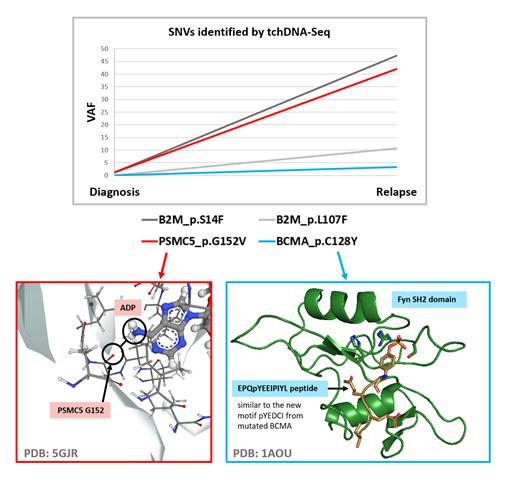Introduction
Proteasome inhibitors (PIs) are standard drugs for the treatment of Multiple Myeloma (MM), bispecific antibodies (BsAbs) and CART cells are rapidly and successfully being integrated into treatment regimens. Still, several current studies have shown that drug resistance remains one of the biggest clinical challenges. For instance, deletions in BCMA (alias TNFRSF17) were shown to confer a target loss and therefore resistance to BCMA CARTs (Da Via et al. Nat Med 2021, Samur et al. Nat Commun 2021) as well as to a CD3xBCMA bispecific T cell-engager (Truger et al. Blood Adv 2021). Besides the extracellular ligand-binding domain, BCMA further consist of a membrane spanning and a cytoplasmatic region that activates cell functions. To date not much is known in regard to alterations affecting the latter and their role in resistance. Here we present genetic profiling of a multi-refractory MM patient who relapsed to PIs, anti- BCMA (Teclistamab) and anti- GPRC5D (Talquetamab) BsAbs.
Methods
We performed FISH and a targeted capture-hybridization DNA sequencing panel (tchDNA-Seq) as previously described in Rosa-Rosa et al. Cancers 2022 in two sequential samples: first a bone marrow biopsy at diagnosis and second, 43 months later, a FFPE biopsy of the retroperitoneal mass of a progression plasmacytoma, after PI but prior Teclistamab treatment. The MM-specific tchDNA-Seq panel includes over 100 genes involved in MM progression, drug resistance, immunotherapy and canonical loci to cover IG rearrangements and frequent translocations. In order to predict the impact of the observed gene mutations on the protein structure, we generated 3D projections using the PyMOL molecular visualization system and references from the Protein Data Bank. The KinasePhos3 program was used to predict the most probable kinase to phosphorylate new, by the mutation generated, sites.
Results
Via FISH, the patient was stratified as a high-risk patient as 13% of the tumor cells showed a del17p at diagnosis, 97% a t(4;14) translocation, and 88% chromosomal gains for 1q21 and 11q13. The patient initially responded well to VRd+HCT. After 3.6 years he relapsed and developed an abdominal plasmacytoma. He was non-responsive to the following Isa-Kd treatment and relapsed again, two months after Teclistamab induction. To the subsequent PomCyDex and Talquetamab treatments he was primary refractory. In the plasmacytoma, four SNVs were detected: PSMC5 p.G152V with a VAF of 42%, BCMA p.C128Y (3%) and the two B2M mutations B2M p.S14F (47%) and B2M p.L107F (11%). At diagnosis, the VAF was 1% for PSMC5 p.G152V and B2M p.S14F, the other two SNVs were absent. In B2M, mutations in residues 13-16 have been associated with impaired protein expression and complex formation (Challa-Malladi et al. Cancer Cell 2011). The PSMC5 SNV was topologically identified within a glycine-rich loop in the ATP binding pocket of the proteasome in direct interaction with the ATP amine group, therefore likely impacting the proteolytic capacity increasing the PI tolerance. B CMA p.C128Y is located in the C-terminal cytoplasmatic tail within a highly conserved 25-aa protein segment (position 119 to 143) that has been shown to be necessary for TRAF association and NF-κB, Elk-1, and JNK activation (Hatzoglou et al. J Immunol 2000). A cysteine is mutated to a tyrosine. With high probability, this new site will be phosphorylated by kinases of the c-Src family (score 0.92), e.g. Fyn (0.71) or Lyn (0.66). Moreover, this new phosphotyrosine would become a binding site for the kinase SH2 domain (Diop et al. Int J Mol Sci 2022).
Conclusions
Here we report emerging mutations in PSMC5 and BCMA, that are likely causal for PI and Teclistamab resistance. PSMC5 p.G152 represents a mutational hotspot as four more PI-resistant patients with substitutions were recently reported in Haertle et al. Cancers 2023. The intracytoplasmatic BCMA SNV creates a new kinase phosphorylation and binding site resulting in aberrant downstream signaling. B2M forms part of the MHC1 molecules, responsible for antigen presentation to CD8+ T cells and the B2M serum level is a prognostic indicator in MM. However, the role of B2M alterations in disease progression and drug resistance needs to be elucidated. Predicting the biological impact based on 3D structural models remains speculative, thus, functional confirmation introducing the BCMA and B2M alterations in cell line models by genetic engineering is pending.
Disclosures
Ayala:Astellas: Speakers Bureau; BMS: Membership on an entity's Board of Directors or advisory committees, Speakers Bureau; Novartis: Membership on an entity's Board of Directors or advisory committees, Speakers Bureau. Kortüm:Pfizer: Honoraria; Takeda: Honoraria; GSK: Honoraria; Janssen: Honoraria; Abbvie: Honoraria; BMS: Honoraria. Martinez Lopez:BMS: Membership on an entity's Board of Directors or advisory committees, Other: Travel grants, Research Funding; Incyte: Membership on an entity's Board of Directors or advisory committees, Research Funding; Pfizer: Membership on an entity's Board of Directors or advisory committees, Other: Travel grants, Research Funding; Sanofi: Membership on an entity's Board of Directors or advisory committees, Other: Travel grants, Research Funding; Janssen: Membership on an entity's Board of Directors or advisory committees, Other: Travel grants, Research Funding.


